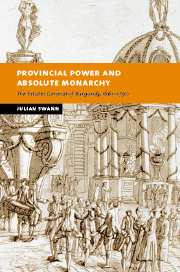Book contents
- Frontmatter
- Contents
- List of illustrations
- List of figures
- List of appendices
- List of map
- Preface
- List of abbreviations
- Map: The duchy of Burgundy in the eighteenth century
- 1 Historians, absolute monarchy and the provincial estates
- 2 Ancien régime Burgundy
- 3 The Estates General of Burgundy
- 4 Nosseigneurs les élus and the officers of the Estates
- 5 The provincial administration: authority and enforcement
- 6 ‘It's raining taxes’. Paying for the Sun King, 1661–1715
- 7 Provincial administration in an age of iron, 1661–1715
- 8 The limits of absolutism: crown, governor and the Estates in the eighteenth century
- 9 Provincial rivalries: the Estates and the Parlement of Dijon in the eighteenth century
- 10 Tax, borrow and lend: crown, Estates and finance, 1715–1789
- 11 An enlightened administration?
- 12 The coming of the French revolution in Burgundy, 1787–1789
- Conclusion
- Appendices
- Bibliography
- Index
10 - Tax, borrow and lend: crown, Estates and finance, 1715–1789
Published online by Cambridge University Press: 05 July 2009
- Frontmatter
- Contents
- List of illustrations
- List of figures
- List of appendices
- List of map
- Preface
- List of abbreviations
- Map: The duchy of Burgundy in the eighteenth century
- 1 Historians, absolute monarchy and the provincial estates
- 2 Ancien régime Burgundy
- 3 The Estates General of Burgundy
- 4 Nosseigneurs les élus and the officers of the Estates
- 5 The provincial administration: authority and enforcement
- 6 ‘It's raining taxes’. Paying for the Sun King, 1661–1715
- 7 Provincial administration in an age of iron, 1661–1715
- 8 The limits of absolutism: crown, governor and the Estates in the eighteenth century
- 9 Provincial rivalries: the Estates and the Parlement of Dijon in the eighteenth century
- 10 Tax, borrow and lend: crown, Estates and finance, 1715–1789
- 11 An enlightened administration?
- 12 The coming of the French revolution in Burgundy, 1787–1789
- Conclusion
- Appendices
- Bibliography
- Index
Summary
By the close of Louis XIV's long and expensive reign the Estates of Burgundy had been pushed to their fiscal limits. The provincial debt stood at record levels, and future revenues from indirect taxation had been pledged for decades in advance. Although the credit of the Estates still inspired confidence amongst investors, concern was undoubtedly growing about their ability to raise further loans against the sombre background of subsistence crises, economic depression and tax arrears. The return of peace in 1714 prevented the crisis from spiralling out of control, and the death of the Sun King coincided with the start of a largely peaceful generation. The Estates were able to take advantage of this more favourable climate to restore their financial affairs, and when a new cycle of conflict began in 1740, with the outbreak of the War of the Austrian Succession (1740–8), they were ready to meet the predictable fiscal onslaught.
The three great wars of the mid-eighteenth century were largely fought on foreign soil, and they never threatened the kingdom with disaster on the scale of the War of the Spanish Succession, but they were all phenomenally expensive. Moreover, the Seven Years War (1756–63) witnessed a series of humiliating military reverses that would shake the very foundations of the monarchy.
- Type
- Chapter
- Information
- Provincial Power and Absolute MonarchyThe Estates General of Burgundy, 1661–1790, pp. 295 - 329Publisher: Cambridge University PressPrint publication year: 2003



